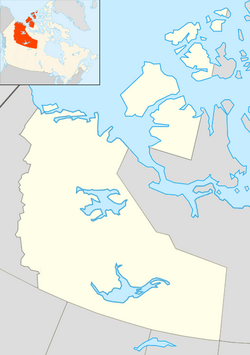Gamèti facts for kids
Quick facts for kids
Gamètì
Rae Lakes
|
||
|---|---|---|
|
||
| Country | Canada | |
| Territory | Northwest Territories | |
| Region | North Slave Region | |
| Constituency | Monfwi | |
| Census division | Region 3 | |
| Incorporated | 4 August 2005 | |
| Area | ||
| • Land | 9.19 km2 (3.55 sq mi) | |
| Elevation | 220 m (720 ft) | |
| Population
(2016)
|
||
| • Total | 278 | |
| • Density | 30.3/km2 (78/sq mi) | |
| Time zone | UTC−07:00 (MST) | |
| • Summer (DST) | UTC−06:00 (MDT) | |
| Canadian Postal code |
X0E 1R0
|
|
| Area code(s) | 867 | |
| Telephone exchange | 997 | |
| - Living cost | 152.5 | |
| - Food price index | 123.3 | |
| Sources: Department of Municipal and Community Affairs, Prince of Wales Northern Heritage Centre, Canada Flight Supplement 2013 figure based on Edmonton = 100 2015 figure based on Yellowknife = 100 |
||
Gamètì (/ˈɡæməti/) is a small community in Canada's Northwest Territories. It is part of the North Slave Region. The community is officially known as the Tłı̨chǫ Community Government of Gamètì. Its name, Gamètì, means "rabbit-net lake" in the Tłı̨chǫ language. This comes from 'Gah' meaning 'rabbit', 'mi' meaning 'net', and 'tì' meaning 'lake' or 'water'. It is one of four Tłı̨chǫ communities that are part of the Tlicho Government. Before August 4, 2005, it was called Rae Lakes.
Contents
A Look Back: Gamètì's History
Gamètì is located in the traditional lands of the Tłı̨chǫ (Dogrib) First Nations people. Long ago, this area was a popular spot for hunting. In the 1960s, elders from nearby Behchokǫ̀ decided to move back to the land. They set up traditional camps in the wilderness. Gamètì grew from one of these camps. Over time, it became a modern community. It now has important services for its people.
How Gamètì Became a Community
Before 2005, Gamètì was not officially a town. It was managed by the Gamètì First Nation, a local Indigenous government. This changed with the Tłı̨chǫ Agreement. This agreement transferred many responsibilities to a new Gamètì Community Government. However, the First Nation is still recognized by the Canadian government.
People and Languages: Gamètì's Demographics
A census is like a big count of all the people living in an area. In the 2021 Census, Gamètì had a population of 252 people. These people lived in 82 homes. This was a small change from its 2016 population of 278 people. The community covers a land area of about 9 square kilometers.
Indigenous Population and Local Languages
According to the 2016 Census, there were 270 Indigenous people living in Gamètì. All of them were First Nations. The main local languages spoken are Dogrib (Tłı̨chǫ) and English. Some people also speak Slavey.
Life in Gamètì: Services and Daily Living
Gamètì has several important services for its residents. The community is served by the Gamètì/Rae Lakes Airport. This airport helps people travel in and out of the community.
Getting Around and Education
Gamètì does not have a road that is open all year. However, an ice road is sometimes built in the winter. This allows people to drive in and out when the lakes are frozen. For education, Gamètì has a daycare for younger children. It also has the Jean Wetrade School, which teaches students up to grade 12. There is also a community learning centre.
Community Facilities
Other services in Gamètì include a post office. There is also a two-member RCMP detachment. This means two police officers help keep the community safe. A health centre with one nurse provides medical care. The Rae Lakes General Store is where people can buy supplies.
Gamètì's Weather: Climate Overview
Gamètì has a subarctic climate (this is a type of cold climate). This means the average temperature throughout the year is usually below freezing. Even though it's cold, Gamètì is below the tree line. This means it has relatively warm, but short, summers.




